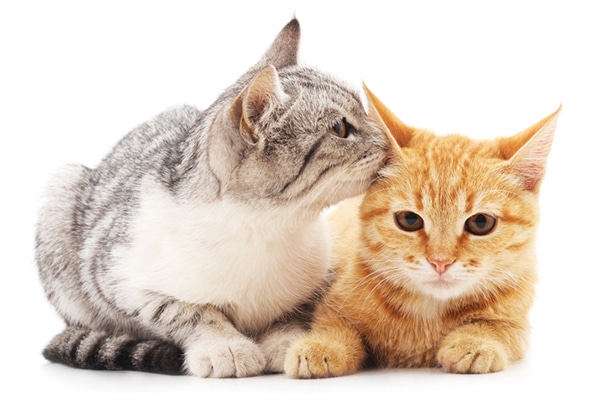Cats in Heat: What Exactly Happens?
The post Cats in Heat: What Exactly Happens? by Catster HQ appeared first on Catster. Copying over entire articles infringes on copyright laws. You may not be aware of it, but all of these articles were assigned, contracted and paid for, so they aren't considered public domain. However, we appreciate that you like the article and would love it if you continued sharing just the first paragraph of an article, then linking out to the rest of the piece on Catster.com.
The symptoms of cats in heat can try the patience of even the most loving pet owners, which is why veterinarians recommend having female cats spayed before the first heat cycle occurs. Cats in heat have entered the phase of the feline reproduction cycle that’s characterized by her receptiveness to males and to mating. This phase is also known as estrus. In the world of cat breeding, unspayed females are known as “queens.”
What is cat estrus? When do cats first go into heat?

When do cats first go into heat? Photography ©Voren1 | Thinkstock.
Cat estrus begins as animals reach sexual maturity, usually at about six months of age, although some cats will go into heat as early as four months and others as late as 10 to 12 months.
Cats are considered to be polyestrous, meaning they have several heat cycles a year (in contrast to dogs, which are diestrous and typically have two heat cycles a year). This means that breeding cats can produce a litter at any time of the year, even though springtime is often considered to be “kitten season.”
Signs of estrus or cats in heat:
Even if you’ve never been around cats in heat before, you’re very likely to know something is going on with your pet — the behaviors she uses to get the attention of a potential mate will no doubt get your attention as well. The signs of cats in heat or cats experiencing estrus can mimic signs of pain or distress in your cat, and include the following:
- Your cat is likely to become extremely affectionate, constantly rubbing up against you, other animals in the household or even the furniture.
- When you stroke or pet your cat, she may instinctively assume the mating position, with her head down low and hindquarters raised high.
- She’ll become noticeably more vocal, and her vocalizations will include unusually loud yowls that are designed to gain the attention of a mate.
- She may spray a fine stream of urine around your home as she marks her territory in an effort to lure in a mate.
- Your cat may exhibit restless pacing, or may roll back and forth on the floor constantly.
- Cats in heat may lose their appetites completely.
- In some cases, cats in heat may persistently lick their genitals, which are likely to be engorged and swollen. You may also notice a bloody discharge.
- Your cat may make continued attempts to escape from your home in her efforts to find a mate. This may include clawing at window screens or dashing out the door when it opens.
How to handle cats in heat:
If you don’t want kittens, keep cats in heat indoors. If cats in heat do get out, they’re more at risk for contracting infectious diseases, such as feline leukemia, from any infected male cats that they attempt to breed with.
Remember that responsible cat breeders carefully screen and select the male cats they breed with their queens, not only to ensure a purebred pedigree, but also to prevent such transmission of disease.
How long are cats in heat?
So, how long are cats in heat? Typically, the estrous phase will last between a week and 10 days. However, if your cat isn’t able to mate and become pregnant, she’ll very likely go into heat again sometime within the next three weeks. Some cats who aren’t allowed to breed may seem to be more or less constantly in heat.
How can you prevent a cat from going into heat?
The only way to prevent the heat cycle from repeating over and over again, along with the distress it causes both you and your pet, is to have your female cat spayed. It is a myth that cats should be allowed to go through one heat cycle or even to have one litter before spaying. Early spaying is widely regarded as the most ethical course for pet owners to take, in light of the millions of animals who are euthanized at pet shelters each year. It’s simply irresponsible to bring another litter of kittens into the world when there are already too few homes for existing animals.
Spaying is considered major surgery because it involves entering the abdomen to remove both ovaries and the uterus, yet the procedure is safe and routine when performed by a qualified vet. And although it’s possible to perform the surgery at any time of the estrous cycle, most veterinarians decline to spay cats in heat because the engorged blood vessels in the reproductive organs create an increased risk of heavy bleeding.
Thumbnail: Photography by karamysh / Shutterstock.
This piece was originally published in 2012.
About the authors
Read more about cats in heat and reproduction on Catster.com:
The post Cats in Heat: What Exactly Happens? by Catster HQ appeared first on Catster. Copying over entire articles infringes on copyright laws. You may not be aware of it, but all of these articles were assigned, contracted and paid for, so they aren't considered public domain. However, we appreciate that you like the article and would love it if you continued sharing just the first paragraph of an article, then linking out to the rest of the piece on Catster.com.




Post a Comment